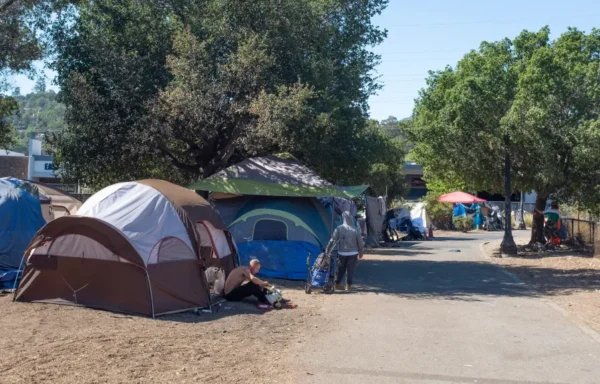
Tents line the Mahon Creek Path in San Rafael on Sept. 8, 2023. (Alan Dep/Marin Independent Journal)
By KRISSY WAITE | kwaite@marinij.com
PUBLISHED: | UPDATED:
Most homeless people in San Rafael want help getting off the street, but they say a lack of affordable housing and access to services are standing in the way, according to data collected by the city.
The city collaborated with the Marin County Department of Health and Human Services and nonprofits to conduct a citywide assessment of camps of homeless people and the services of greatest interest to the occupants.
The survey, which was conducted Dec. 11 to 13, indicated that many homeless people are eager for health services and case management, and would like to be added to housing lists, but report they are not receiving such services despite eligibility.
The survey cost the city about $15,000, according to Chris Hess, assistant director of community development.
“The Encampment Needs Assessment Survey conducted in San Rafael shines a light on the needs of the individuals experiencing homelessness in our community, particularly in the Mahon Creek area,” Vice Mayor Eli Hill said. “The data and insights gleaned from this effort will guide our efforts to secure grant funding to support these individuals as well as better align our partnership with the county of Marin.”
The goal of the study was to identify barriers people face in receiving case management, housing assistance and transportation to reunite with family. Additionally, the survey aimed to get information that can help the city develop policies, programs and a response strategy.
The city partnered with the St. Vincent de Paul Society of Marin, Downtown Streets Team, Community Action Marin and Ritter Center nonprofit organizations to conduct the 35-question English-and-Spanish survey. Organizers also did interviews with unhoused people in the city’s largest camps.
The survey teams received 60 responses, the majority from occupants of the Mahon Creek camp. Staff counted 70 tents at the time of the survey.
“Many of these individuals experiencing homelessness have barriers of trust, which would impede their ability to respond to the survey openly and honestly,” Hess said.
Hess said that to address this, the city created survey teams of nonprofit staff and people from the Marin County Lived Experience Advisory Board who had experienced homelessness. Surveyors explained the purpose of the survey and how participation would help the city better understand their experiences. The respondents were kept anonymous.
“The result of these efforts was an estimated 85% participation rate among the surveyed encampments,” Hess said.
The results showed that 66% of those surveyed have lived in San Rafael for more than five years — 31% between five and 20 years, and 35% more than 20 years. Only seven of the participants arrived within the last year. However, only 54 of the 60 respondents answered this question.
“We know from past surveys that individuals experiencing homelessness have long-term ties to Marin County and the city of San Rafael and are not arriving here from other communities,” Hess said.
The median age of people in the camps is 46. Most people surveyed were between the ages of 45 and 54; 15 people were between the ages 35 and 44; 13 were between 25 and 34 years old; and eight people were between 65 and 64. Only three were 65 years or older, and three were 18 to 24 years old.
Laurel Hill, director of safety net services at Community Action Marin, said that while the survey was needed, the results only confirmed what the specialists already knew: unhoused people want to be housed, but access to subsidized housing is a big obstacle.
“I didn’t see anything that was really surprising to me,” Hill said. “Maybe the length of residency in Marin County was a bit longer than expected, but I think the most important is that the people that are unhoused in Marin would like to be housed and the biggest barrier is affordable housing.”
Survey participants were asked if they were listed on the county’s coordinated entry system, a housing and service prioritization list, or on the Marin Housing Authority’s Section 8 housing waitlist. The majority — nearly 70% — did not know their status on the lists, but when staff cross-checked with the county data, 55% of them were listed in the coordinated entry system as of February.
Other survey questions centered around mental health services and how to improve current conditions. Forty-five people said they were interested in case management, but only 17 have a case manager, according to county data.
Hill said he is seeing more general outreach staff take on case management duties, like helping people register for services, obtain identification and secure a source of income. The results note that three more full-time staff positions would be necessary to fill the need.
Most respondents said they were interested in services relating to mental health, health care, Social Security disability income, supplemental security income and general relief. However, they also noted that mental health services reach only a small number of people, and that they are receiving medical services and income benefits at rates below their eligibility.
The most important result of the survey, Hess said, might be that people said essential services are not reaching them.
“The survey identified a willingness to engage in those services,” Hess said. “Using this information, the city and the county have recently jointly applied for state funding to provide service teams and housing resources dedicated especially to this encampment.”
